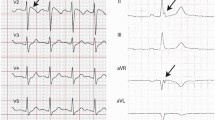Abstract
Rigid spine syndrome (RSS) is a group of childhood-onset muscle disorders characterized by marked limitation of flexion of the spine. Various cardiac changes have been documented in case reports. This study reports on a cardiac evaluation of nine patients with the “vacuolar variant” of RSS. Noninvasive cardiac evaluation entailed creatine kinase levels, full-inspiration chest roentgenograms, standard 12-lead ECG, and 24-h ambulatory ECG recording, as well as M-mode and two-dimensional echocardiography with Doppler study. Heart auscultation was abnormal in five patients. Creatine kinase MB fraction was normal in all patients. Chest roentgenogram showed scoliosis (five of nine), kyphosis (one of nine), severe anterior-posterior flattening of the chest cavity (two of nine), elevated hemidiaphragm (one of nine), caved-in appearance of upper lobes (two of nine), and symmetry of lung volumes (one of nine). Twelve-lead ECG abnormalities indicated right-sided heart disease (three of nine). Echocardiogram showed mitral valve prolapse (five of nine) with regurgitation (three of five) and evidence of pulmonary hypertension (three of nine). Ambulatory ECG recorded paroxysmal tachyarrhythmias in hypoxic or hypercapnic patients (three of nine). There was no correlation between any cardiac abnormalities and patient weakness. Mitral prolapse/regurgitation may have a developmental association with this congenital myopathy. Findings of cor pulmonale were due to the restrictive chest wall defect and respiratory muscle weakness. Paroxysmal tachyarrhythmias were due to hypoxia or hypercapnia. There was no evidence of a primary cardiomyopathy.


Similar content being viewed by others
References
Bon Tempo CP, Ronan J, de Leon AC, Twigg HL (1975) Radiographic appearance of the thorax in the systolic click-late systolic murmur syndrome. Am J Cardiol 36:27–31
Colver AF, Steer CR, Godman MJ, Uttley WS (1981) Rigid spine syndrome and fatal cardiomyopathy. Arch Dis Child 56:148–151
Davies MK, Mackintosh P, Cayton RM, Page AJF, Shiu MF, Littler WA (1980) The straight back syndrome. Q J Med 49:443–460
De Leon AC, Perloff JK, Twigg H, Majd M (1965) The straight back syndrome: clinical cardiovascular manifestations. Circulation 32:193–203
Dubowitz V (1971) Recent advances in neuromuscular disorders. Rheumatol Phys Med 11:126–130
Dubowitz V (1973) Rigid spine syndrome: a muscle syndrome in search of a name. Proc Roy Soc Med 66:219–220
Dubowitz V (1997) 50th ENMC international workshop on congenital muscular dystrophy. Neuromusc Disord 7:539–547
Emery AEH, Dreifuss FE (1966) Unusual type of benign X-linked muscular dystrophy. J Neurol Neurosug Psychiatry 29:338–342
Gardin JM, Henry WL, Savage DD (1979) Echocardiographic measurements in normal subjects. Evaluation of an adult population without clinically apparent heart disease. J Clin Ultrasound 95:439–447
Lotz BP, Stübgen JP (1993) The rigid spine syndrome: a vacuolar variant. Muscle Nerve 16:530–536
Matsuo S, Yoshioka M, Yano K Hashiba K (1973) Straight back syndrome: clinical and hemodynamic study of 9 cases. Am Heart J 86:828–834
Mendell JR, Florence J (1990) Manual muscle testing. Muscle Nerve 13(Suppl):16–20
Poewe W, Villeit H, Sluga E, Mayr U (1985) The rigid spine syndrome—a myopathy of uncertain nosologic position. J Neurol Neurosurg Psychiatry 48:887–893
Prineas RJ, Crow RS, Blackburn H (1986) The Minnesota code manual of electrocardiographic findings. Standards and procedures for measurement and classification. Wright, Boston
Ras GJ, van Staden M, Schultz C, Stübgen JP, Lotz BP, van der Merwe C (1994) Respiratory manifestations of rigid spine syndrome. Am J Respir Crit Care Med 150:540–546
Sahn DJ, DeMaria A, Kisslo J, Weyman A (1978) Recommendations regarding quantitation in M-mode echocardiography: results of a survey of chocardiographic measurements. Circulation 58:1072–1083
Takase Y, Yamamato K, Nogaki H (1990) Rigid spine syndrome associated with cardiomyopathy. Jpn J Med 29:555–559
Thery CL, Krivovosic I, Dewailly PH (1981) Congestive cardiomyopathy associated with a stiff column: “rigid spine syndrome.” Arch Mal Coeur 74:985–989
Van Munster ETL, Joosten EMG, Van Munster-Uijtdehaage MAM, Kruls HJA, Terlaak HJ (1986) The rigid spine syndrome. J Neurol Neurosurg Psychiatry 49:1292–1297
WHO/ISFC Task Force (1978) Definition of terms related to cardiac rhythm. Am Heart J 95:796–806
Author information
Authors and Affiliations
Corresponding author
Rights and permissions
About this article
Cite this article
Stübgen, JP. Rigid Spine Syndrome: A Noninvasive Cardiac Evaluation. Pediatr Cardiol 29, 45–49 (2008). https://doi.org/10.1007/s00246-007-9056-4
Received:
Revised:
Accepted:
Published:
Issue Date:
DOI: https://doi.org/10.1007/s00246-007-9056-4




